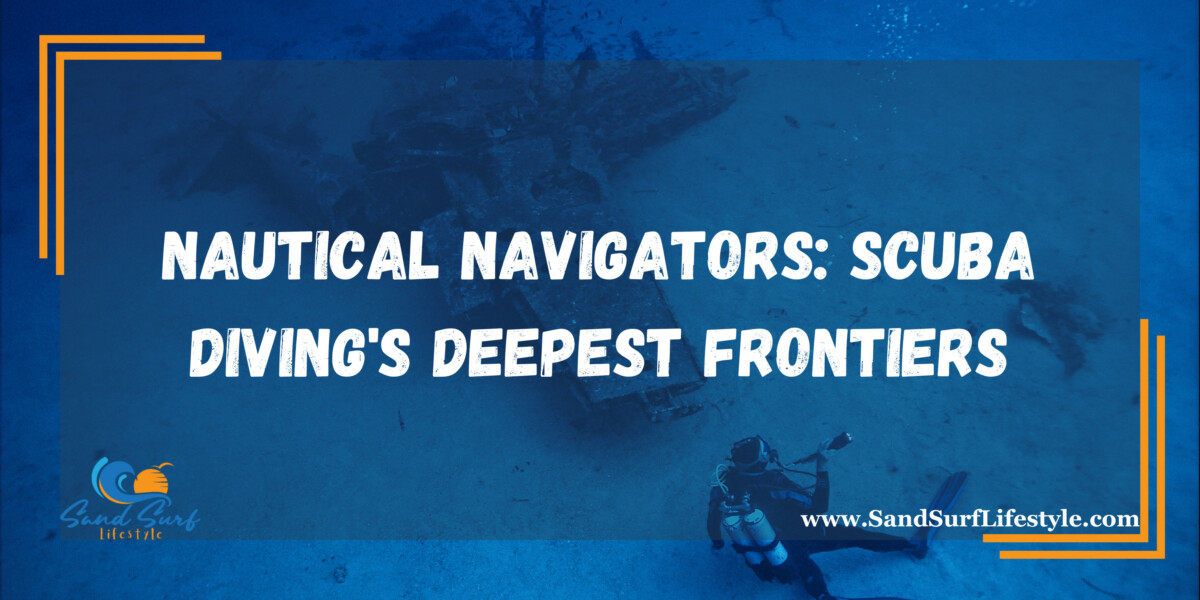Scuba diving is a mesmerizing journey into the depths of our planet’s last uncharted frontier—the underwater world. As adventurers and explorers, humans have always sought to push the boundaries of what’s possible, and scuba diving is no exception. One of the most intriguing questions in the world of diving is: What is the record for scuba diving depth?
The Pioneers of Deep Diving

Before we dive into the record depths, it’s essential to understand the history of deep-sea exploration and the pioneers who paved the way. Early diving expeditions were limited by technology and knowledge of the ocean’s depths. Divers relied on simple equipment, such as leather suits and bronze helmets, which allowed them to descend only a few meters.
1. Early Dive Records
In the late 19th and early 20th centuries, the world of underwater exploration was in its infancy. Divers of this era relied on “hard-hat” diving suits, which marked a significant leap in technology from previous methods. These suits were pressurized, providing a controlled environment for divers to venture into the depths of the ocean. However, compared to today’s standards, the records achieved during this period were relatively modest, with depths of around 100 meters being the pinnacle of achievement.
These early dive records, while seemingly unremarkable by contemporary standards, were groundbreaking achievements in their time. They demonstrated humanity’s growing understanding of underwater environments and the capacity to overcome the physical challenges of deep-sea exploration. These pioneers paved the way for the remarkable advancements that would follow in the world of scuba diving.
2. Jacques Cousteau and the Aqua-Lung
The true revolution in scuba diving occurred in the mid-20th century with the groundbreaking invention of the Aqua-Lung by Jacques-Yves Cousteau and Emile Gagnan. This innovation marked a turning point in underwater exploration. The Aqua-Lung was an open-circuit scuba system that allowed divers to breathe underwater without being tethered to the surface. It consisted of a regulator that supplied compressed air from a tank, enabling divers to explore the underwater world more freely and safely than ever before.
This invention dramatically increased diving depths and duration, as divers were no longer limited by surface-supplied air hoses. Jacques Cousteau, a pioneer of oceanography and underwater filmmaking, played a pivotal role in popularizing scuba diving and showcasing its potential for scientific research and marine conservation. The Aqua-Lung’s impact on the world of scuba diving cannot be overstated, as it opened the door to a new era of exploration beneath the waves, setting the stage for modern deep-sea diving records and adventures.
To learn if scuba diving certification is necessary, check out this article.
The Changing Face of Deep Diving
With the advent of the Aqua-Lung, deep diving records began to soar. Divers worldwide were inspired to venture deeper into the oceans, setting new milestones and pushing the boundaries of what was once considered impossible.
1. The Deep Dive Records
The record for scuba diving depth has been a subject of fierce competition and continuous advancement. Over the years, the record depths have increased substantially:
1960s – The 100-Meter Mark: In the early 1960s, scuba diving enthusiasts embarked on a quest to breach the 100-meter depth barrier—a monumental feat during this era. Pioneering divers such as Enzo Maiorca and Jacques Mayol emerged as trailblazers in this pursuit. Their daring dives not only pushed the boundaries of human capability but also marked a significant turning point in the history of deep-sea exploration.
Breaking the 100-meter mark was a profound achievement, considering the limited technology and knowledge available at the time. Divers faced daunting challenges, including the effects of water pressure and the need for specialized equipment. These early records set the stage for further advancements in diving technology and techniques, inspiring a new generation of deep-sea adventurers to explore the mysteries hidden beneath the ocean’s surface.
1970s – Deeper into the Abyss: The 1970s witnessed a relentless drive to venture deeper into the abyss. As technology and understanding of deep-sea conditions improved, divers like Jacques Mayol continued their pursuit of greater depths. The “Deep Joy” era saw divers reaching depths exceeding 105 meters and beyond, continuously pushing the boundaries of what was deemed possible.
Divers of this era undertook increasingly daring feats, setting new records with each descent. Their tenacity and courage not only expanded our knowledge of deep-sea environments but also demonstrated the human spirit’s resilience in the face of extreme challenges. These divers paved the way for future record-breakers and contributed significantly to the evolution of deep-sea diving.
1980s – The Deepest Dive to Date: The 1980s marked a historic moment in deep-sea diving when Jacques Mayol and Umberto Pelizzari achieved an astonishing depth of 101 meters in a single breath, without the use of scuba tanks. This remarkable achievement captivated the world, captivating the imagination of enthusiasts and underscoring the extraordinary potential of human deep-sea exploration.
Mayol and Pelizzari’s dive highlighted the remarkable capacity of the human body to adapt to the extreme pressures of the deep. It was a pivotal moment in demonstrating the possibilities of free diving, inspiring others to test their limits, and further pushing the boundaries of underwater exploration. This era served as a testament to the indomitable human spirit and its relentless pursuit of new frontiers beneath the waves.
1990s – Technical Diving Emerges: The 1990s marked the emergence of technical diving, a discipline that allowed divers to explore deep wrecks and intricate cave systems. With improved equipment and specialized training, divers were now able to delve into the ocean’s depths with greater precision and safety.
During this era, records were consistently shattered as explorers like Sheck Exley descended to depths as profound as 283 meters in a Mexican cave. Technical diving opened up new possibilities for deep-sea exploration, enabling divers to venture into complex underwater environments that were once considered beyond reach. This decade witnessed a surge in the exploration of underwater caves and shipwrecks, offering a wealth of knowledge about our submerged world.
2000s – The “No-Limits” Discipline: The 2000s ushered in the era of “no-limits” diving, a discipline that pushed the boundaries of deep diving to unprecedented extremes. In this category, divers descended with specialized equipment and ascended via controlled methods, often involving lift bags or other innovative technologies.
In 2005, Herbert Nitsch set an astonishing record by plunging to a depth of 214 meters in the “no-limits” category. This accomplishment showcased the audacious nature of deep divers and their willingness to explore the ocean’s most profound recesses. The “no-limits” discipline epitomized the fusion of technology, bravery, and a relentless pursuit of deep-sea exploration.
2010s – The Abyss Beckons: The 2010s continued to captivate adventurers worldwide with the allure of deep diving. In 2014, Ahmed Gabr, an Egyptian diver, etched his name into history by establishing a new scuba diving depth record. Gabr reached an astonishing 332.35 meters in the Red Sea, a feat that mesmerized the world and underscored the indomitable human spirit’s capacity for deep-sea exploration.
This achievement marked the zenith of scuba diving records, capturing the imagination of those who dared to explore the mysteries concealed in the depths of our oceans. The 2010s reaffirmed that, as long as the abyss beckons, there will always be intrepid explorers willing to descend to the farthest reaches of the underwater world, pushing the boundaries of human capability and knowledge.
2. The Human Factor
Behind each record for deep dives lies a captivating narrative of human determination, unyielding passion, and the relentless pursuit of dreams. Divers such as Tanya Streeter, Natalia Molchanova, and Nuno Gomes have left an indelible mark on the world of deep-sea exploration. Their remarkable achievements and unwavering dedication have not only shattered records but have also inspired countless others to embark on their own underwater journeys.
Tanya Streeter’s incredible free diving feats, including her record-breaking “no-limits” dive to 160 meters, showcased the incredible potential of the human body in the deep sea. Natalia Molchanova’s mastery of free diving made her an iconic figure, inspiring divers worldwide. Nuno Gomes, with his relentless pursuit of ever-greater depths, demonstrated the audacity of human ambition in the face of daunting challenges.
These divers serve as beacons of inspiration, encouraging future generations to explore the uncharted depths, both physically and metaphorically.
3. The Role of Technology
Technological advancements have played a pivotal role in enabling divers to reach record depths safely and effectively. The evolution of diving gear, mixed gases, and decompression algorithms has transformed the landscape of deep-sea exploration.
Improved diving equipment, from advanced wetsuits and drysuits to cutting-edge regulators and buoyancy control devices, provides divers with the comfort and protection needed to endure the extreme conditions of deep dives. Mixed gases, such as helium and nitrox, allow for better management of decompression and oxygen toxicity, extending the duration and safety of dives.
Decompression algorithms, which calculate dive profiles and ascent rates, have become increasingly sophisticated, reducing the risk of decompression sickness. Additionally, underwater navigation tools and communication devices have enhanced diver safety and situational awareness.
In essence, technology has unlocked the deep sea’s secrets, making previously unimaginable dives not only possible but also manageable.
4. Training and Safety
Safety is paramount in the world of deep diving, and rigorous training is essential to prepare divers for the unique challenges they will encounter in the underwater world. Leading organizations like the Professional Association of Diving Instructors (PADI) and the Technical Diving International (TDI) have developed comprehensive courses that instill the skills and knowledge required for deep diving.
Deep diving training covers topics such as advanced buoyancy control, gas management, equipment maintenance, and the intricacies of decompression. Divers learn to navigate complex underwater environments, handle emergencies, and make critical decisions in high-pressure situations.
Safety protocols, such as buddy systems and redundant equipment, are emphasized to minimize risks. Divers are also educated on recognizing and responding to signs of nitrogen narcosis, oxygen toxicity, and decompression sickness.
By undergoing rigorous training and adhering to safety guidelines, divers are better prepared to embark on their deep-sea adventures, ensuring that their pursuit of record depths is conducted with a strong focus on safety and responsible exploration.
Challenges and Risks

While deep diving is an exhilarating endeavor, it is not without its challenges and risks. The deep-sea environment presents unique obstacles that divers must overcome to ensure their safety and success.
1. Pressure and Equalization
The immense pressure at extreme depths is one of the most formidable challenges faced by deep-sea divers. As divers descend deeper into the ocean, the water pressure increases exponentially. To counteract this pressure, divers must continuously equalize the pressure in their ears and sinuses. Failure to do so can result in barotrauma, a condition where the pressure differential between the inside and outside of the body causes injury. Barotrauma can lead to painful ear or sinus injuries and, in severe cases, damage to the eardrum.
Divers employ various techniques to equalize, such as swallowing, yawning, or using the Valsalva maneuver (exhaling against a closed nose and mouth). Proper equalization is crucial to avoid discomfort and potential injury, highlighting the importance of training and technique in deep-sea diving.
2. Narcosis and Oxygen Toxicity
Deep-sea divers are susceptible to two critical physiological effects related to breathing gases at extreme depths: nitrogen narcosis and oxygen toxicity. Nitrogen narcosis, often referred to as “rapture of the deep,” occurs as divers breathe compressed air containing nitrogen. At great depths, the increased partial pressure of nitrogen can lead to symptoms similar to alcohol intoxication, including impaired judgment, confusion, and coordination problems. This condition can be hazardous if not managed properly.
Oxygen toxicity, on the other hand, becomes a concern as divers descend to significant depths. As the partial pressure of oxygen rises with depth, it can lead to seizures, convulsions, and other central nervous system effects. To mitigate these risks, divers often use specialized gas mixtures, such as helium-based ones, to reduce the percentage of nitrogen and oxygen in their breathing gas.
3. Decompression Sickness
Decompression sickness, commonly known as “the bends,” is a potentially life-threatening condition that occurs when divers ascend too quickly from great depths. During deep dives, nitrogen dissolves into body tissues. Ascending too rapidly can cause nitrogen to come out of solution in the form of bubbles, leading to various symptoms, including joint pain, neurological issues, and organ damage.
To prevent decompression sickness, divers must adhere to strict decompression schedules, which involve ascending slowly and stopping at predetermined depths to allow excess nitrogen to off-gas safely. This process ensures that the nitrogen in the body returns to a safe level before reaching the surface. Failing to follow proper decompression procedures is a significant risk for divers exploring deep-sea environments.
4. Hypothermia and Darkness
Deep-sea divers face the challenge of extreme temperatures as they descend to greater depths. Water temperatures can drop significantly, leading to the risk of hypothermia, especially during prolonged dives. Even with appropriate wetsuits or drysuits, the cold can pose a significant threat to divers’ safety and comfort.
Additionally, as divers venture deeper, natural light diminishes rapidly. Darkness sets in, reducing visibility and orientation. Navigating in the dark depths requires specialized training and equipment, including powerful underwater lights and navigation aids. The combination of frigid waters and darkness can create an eerie and disorienting environment, emphasizing the importance of experience and preparation for deep-sea divers.
5. Equipment Failure
Deep-sea diving relies heavily on complex equipment, including regulators, tanks, buoyancy control devices, and dive computers. The reliance on this equipment makes the risk of mechanical failure an ever-present concern. Equipment failure can range from minor inconveniences, such as a malfunctioning dive light, to life-threatening situations like a regulator failure or a ruptured air tank.
Divers must undergo rigorous training not only to use their equipment effectively but also to handle emergencies should equipment failure occur. Regular maintenance and thorough equipment checks before each dive are essential safety practices. Moreover, having backup equipment and redundant systems, such as alternate air sources and backup lights, can be critical in mitigating the risks associated with equipment failure. Divers must be prepared to respond calmly and effectively to equipment emergencies in the challenging environment of the deep sea.
To learn how age factors into scuba diving adventures, check out this article.
Conclusion
The record for scuba diving depth is a testament to human curiosity and the indomitable spirit of exploration. From the early pioneers in hard-hat diving suits to the modern-day technical divers and “no-limits” specialists, each era has contributed to the evolution of deep diving. With advancements in technology, training, and safety measures, divers continue to push the boundaries of what is possible, plumbing the depths of our planet’s last great frontier.
As records are shattered and new depths are reached, the allure of the abyss will continue to captivate the hearts and minds of adventurers worldwide. While the risks are real, the rewards are immeasurable—the chance to glimpse the mysteries that lie beneath the surface of our oceans, to explore the uncharted, and to push the limits of human endurance. The record for scuba diving depth will undoubtedly continue to evolve, reflecting the remarkable achievements of those who dare to venture where few have gone before.
Please note that the contents of this blog are for informational and entertainment purposes only and should not be construed as legal advice. Any action taken based on the information provided in this blog is solely at your own risk. Additionally, all images used in this blog are generated under the CC0 license of Creative Commons, which means they are free to use for any purpose without attribution.

